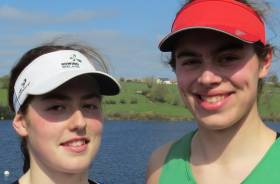Displaying items by tag: Rhiannon O'Donoghue
Fifth for Ireland at World Junior Championships
#Rowing: Ireland’s Molly Curry and Rhiannon O’Donoghue finished fifth in the junior double at the World Rowing Junior Championships in Tokyo. The race was won by the outstanding Lisa Bruijnincx and Jacobien van Westreenen of the Netherlands. The Dutch pushed China into second. Behind them Germany lost out to Lithuania in the battle for bronze.
Curry and O’Donoghue initially fought it out with Greece for fifth. They won this battle and made up metres on Germany, but could not quite push into the battle for medals.
World Rowing Junior Championships, Tokyo, Day Five (Irish interest)
Men
Junior Four, coxed – A Final: 1 Germany 6:32.41, 2 South Africa 6:32.71, 3 China 6:33.90; 4 Ireland (J O’Donovan, M Gallagher, J Dorney, J Kearney; cox: L O’Regan) 6:34.82.
Women
Junior Double Sculls – A Final: 1 Netherlands 7:25.50, 2 China 7:27.66, 3 Lithuania 7:30.23; 5 Ireland (R O’Donoghue, M Curry) 7:38.08
#Rowing: Ireland’s Molly Curry and Rhiannon O’Donoghue won their repechage and qualified for the A/B semi-finals at the World Junior Championships in Tokyo.
The Ireland junior women’s double overhauled Hungary in an impressive move. With 300 metres to go they were down; they drew level at 1750 and then motored clear to win by just over a length.
Ireland’s junior men’s coxed four had earlier qualified for their A Final by taking second in their heat.
World Rowing Junior Championships, Day Two (Irish interest)
Men
Junior Four, coxed – Heat One (First Two to A Final; rest to Repechage): 1 China 6:18.13, 2 Ireland (J O’Donovan, M Gallagher, J Dorney, J Kearney; cox: L O’Regan) 6:18.29; 3 South Africa 6:18.87.
Women
Junior Double Sculls – Repechage One (First Two to A/B Semi-Finals; rest to C/D Semi-Finals): 1 Ireland (R O’Donoghue, M Curry) 7:10.06, 2 Hungary 7:13.17.
#Rowing: Ireland’s Molly Curry and Rhiannon O’Donoghue finished second in their heat of the junior double sculls at the World Junior Championships in Tokyo this morning.
There was just one direct qualification spot for the A/B Semi-Finals, and the Netherlands were outstanding winners of this race. Lisa Bruijnincx and Jacobien van Westreenen made strong claims for being the best crew in this class with a big win.
Curry and O’Donoghue fought an exciting battle with Italy in the second half and won this by a length and a third. Greece, China and Belgium were the other heat winners.
Because of a worry about adverse weather, racing was run at five minute intervals, which brought forward the time of this heat.
World Rowing Junior Championships, Tokyo, Day One (Irish interest)
Women
Junior Double Sculls – Heat Four (Winner to A/B Semi-Final; rest to Repechages): 1 Netherlands 7:08.18; 2 Ireland (R O’Donoghue, M Curry) 7:16.55, 3 Italy 7:19.59.
O'Driscoll and O'Donovan Trialled in a Four
#Rowing: An Ireland heavyweight four of Mark O’Donovan, Fionnan Crowley, Andy Harrington and Shane O’Driscoll got its first outing in the second session of the Ireland Trials on Saturday. Their test against Ronan Byrne and Philip Doyle – who did have a handicap of 15 seconds – ended with a victory for the double.
The pair of Monika Dukarska and Aifric Keogh got a battle from the junior double of Molly Curry and Rhiannon O’Donoghue, in a race won by lightweight single sculler Fintan McCarthy.
At the London Head of the River, provisional rankings placed Commercial’s senior eight 20th.































































